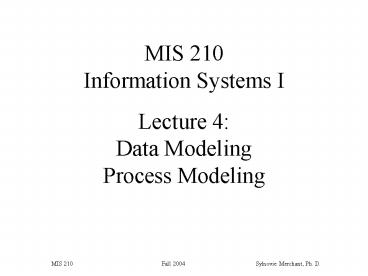Lecture 4: Data Modeling Process Modeling - PowerPoint PPT Presentation
Title:
Lecture 4: Data Modeling Process Modeling
Description:
MIS 210 Information Systems I Lecture 4: Data Modeling Process Modeling – PowerPoint PPT presentation
Number of Views:74
Avg rating:3.0/5.0
Title: Lecture 4: Data Modeling Process Modeling
1
Lecture 4Data ModelingProcess Modeling
MIS 210 Information Systems I
2
Data Models
3
Entity-Relationship Diagrams
- Data-oriented approach
- uses the data and the relationships among data to
model requirements - purpose is to show the data used in the system
- good for modeling data stores from a DFD
- A representation of organizational data.
- Shows the rules about the meanings and
interrelationships among the data.
4
E-R Diagrams
- Defined
- A graphical representation of an E-R model.
- E-R model
- a detailed, logical representation of the
entities, associations, and data elements for an
organization or business area.
5
E-R Symbols
Entity
Attribute
Relationship
6
Terminology
- Entity
- a thing in the real world
- has an independent existence
- Attribute(s)
- One specific piece of information about a thing
- a property of the entity
- has a value (or value set or domain)
- Cardinality
- the number of instances of an entity that are
associated with another entity - a single occurrence of an entity
7
Data Entities
- An Entity is a thing the users need to know (i.e,
record) something about.
8
Types of Things
9
Types of Attributes
- Identifier (primary key / key attribute)
- An attribute (or attributes) selected as the
unique, identifying characteristic for an entity. - Foreign Key
- An attribute (or attributes) in one database
table that is the primary key in another database
table
10
Attributes and Their Values
- All videos/DVDs have the following attributes
- Product ID number
- Product Name
- Product Description
- Category ID
- Supplier ID
- Serial Number
- Each video/DVD has a value for each attribute
- 1
- Woodstock
- Concert
- Other
- WRNRBR
- DVD19925C1
11
Relationships
- Relationship
- Naturally occurring association among specific
things - Occur in two directions
- Cardinality/multiplicity
12
Relationships
- Degree of Relationship
- number of entities that participate in that
relationship - Unary (recursive)
- degree one
- A relationship between instances of one entity.
- Binary
- degree two
- A relationship between instances of two entities
- Ternary
- A relationship between instances of three
entities
13
Cardinality of Relationships
14
Relationships and Cardinality
15
Trucking.One Approach
Truck ID Volume Weight
makes
m
1
Truck
Trips
1
1
m
delivers to
Retail Stores
carries
m
Shipment Number Shipment Volume Weight Destinatio
n
stored at
m
m
Warehouses
Shipment
16
Trucking.Another Approach
Truck ID Volume Weight
makes
m
1
Truck
Trips
1
1
m
delivers to
Retail Stores
carries
m
Shipment Number Shipment Volume Weight Destination
stored at
m
m
Warehouses
Shipment
17
Data Dictionary
18
Data Dictionary Defined
- the data dictionary collects and coordinates
specific data terms, and it confirms what each
term means to different people in the
organization. - Kendall Kendall
19
Data Dictionary(aka, Project Repository)
- Repository for all primitive-level data
structures and data elements within a system. - Use information from DFDs or ERDs to create the
DD - DD details each of the data items, data flows,
processes, etc. in a system - For example DD entry for data items would show
characteristics such as size, type, description,
ranges, etc.
20
Process Models
21
Process Modeling
- Focus on the internal structure and processes in
the DFD - Most popular models
- Structured English
- Decision Tables
- Decision Trees
22
Structured English
- Form of English used to specify the processes in
a DFD - Makes use of nouns and action verbs
- Similar to pseudocode
23
Structured English ExampleEnd of Month Processing
- DO FOR EACH INVENTORY ITEM
- COUNT STOCK IN STOCK ROOM
- ENTER COUNT ON INVENTORY SHEET
- END DO
24
Decision Tables
- Lays out the logic of complex problems where
there are multiple actions based on multiple
decisions. - Four components
- conditions
- decision rules
- actions
- action entries
25
Decision Tables
- The total possible number of decision rules
represents the total possible combinations, or
permutations, of the condition values - For example, for yes or no values
- number of decision rules 2n
- For three conditions with yes or no values
- number of decision rules 2n 23 8
26
Decision Tables
- For a range of values
- example, age 118 to 20, 221-30, 331-40,
441-50, 550 or over - five (5) values for this condition
- What if there are a combination of different
values - yes or no values
- five values
- total possible values 2 x 510
27
Decision Trees
- A graphical representation of a decision
structure. - Difficult to use for a complex situation.































